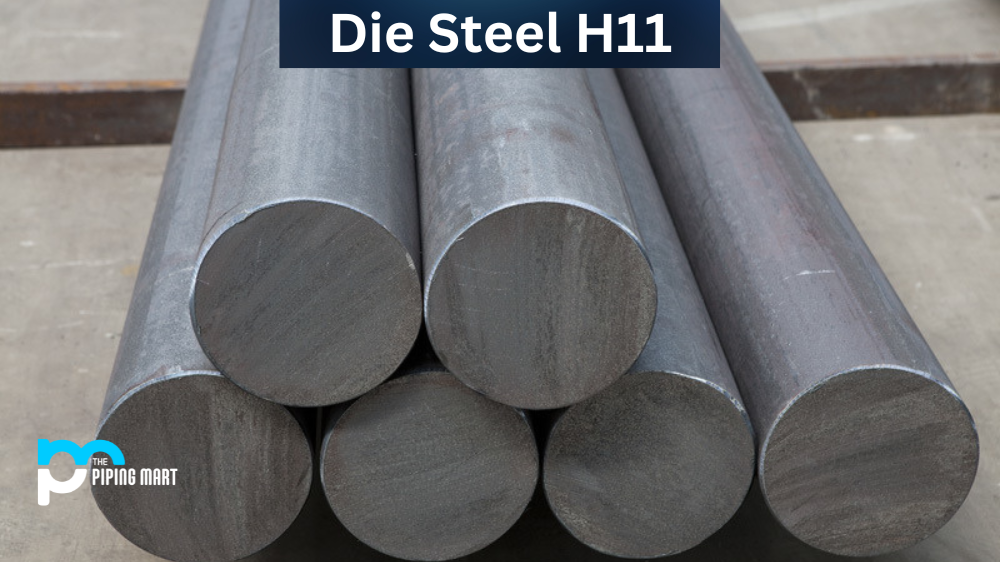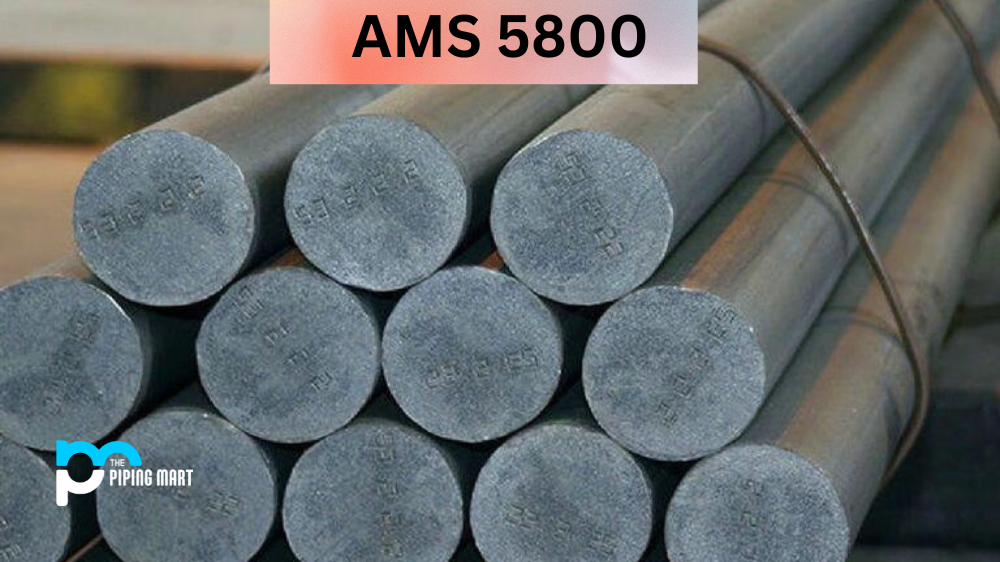When it comes to manufacturing durable and reliable components, die steel H11 is a popular choice. This tool steel is known for its excellent wear resistance and toughness, making it an ideal choice for applications that require parts that can stand up to harsh environments. Let’s take a look at the composition, properties, uses, corrosion resistance, heat resistance, and machining of die steel H11.
H11 Tool Steel Chemical Composition
Die Steel H11 is composed of chromium (Cr), molybdenum (Mo), vanadium (V), and iron (Fe). The Cr provides strength and hardness, while Mo increases toughness and wear resistance. The V increases the metallurgical stability of the alloy while the Fe acts as a binding agent.
| Element | Content (%) |
|---|---|
| Carbon, C | 0.33-0.43 |
| Manganese, Mn | 0.20-0.50 |
| Silicon, Si | 0.80-1.20 |
| Chromium, Cr | 4.75-5.50 |
| Nickel, Ni | 0.3 |
| Molybdenum, Mo | 1.10-1.60 |
| Vanadium, V | 0.30-0.60 |
| Copper, Cu | 0.25 |
| Phosphorous, P | 0.03 |
| Sulfur, S | 0.03 |
| Iron, Fe | Balance |
H11 Tool Steel Chemical Properties
Die Steel H11 is a versatile material with a variety of chemical properties that make it an ideal choice for a wide range of industries. It offers excellent hardness and wear resistance, while its chemical composition ensures great toughness and ductility. Additionally, this steel is heat resistant and able to work at high temperatures without damage or loss in performance, making it suitable for applications where long-term reliability is required. It also exhibits good machinability, allowing products to be crafted with precision and accuracy. Thanks to its features, Die Steel H11 offers consistent results every time and is an ideal solution for numerous manufacturers.
H11 Tool Steel Mechanical Properties
Die Steel H11 has a high tensile strength of about 1020 MPa and good ductility. It also has an excellent fatigue strength which makes it suitable for applications where parts are subjected to cyclic loadings, such as in die-casting dies. It also has good impact toughness, which allows it to withstand impacts from tools or machines during operation.
| Properties | Metric | Imperial |
|---|---|---|
| Hardness, Rockwell C (air cooled from 982°C, 45 mins) | 52.5 | 52.5 |
| Hardness, Rockwell C (air cooled from 1010°C, 45 mins) | 56 | 56 |
| Hardness, Rockwell C (air cooled from 1038°C, 45 mins) | 57 | 57 |
| Modulus of elasticity | 207 GPa | 30000 ksi |
| Modulus of elasticity (@538°C/1000°F) | 159 GPa | 23000 ksi |
| Modulus of elasticity (@204°C/400°F) | 190 GPa | 27500 ksi |
| Charpy impact (V-notch; air cooled from 1010°C;535°C temper temperature) | 13.6 J | 10.0 ft-lb |
| Charpy impact (V-notch; air cooled from 1010°C;650°C temper temperature) | 27.1 J | 20.0 ft-lb |
| Charpy impact (V-notch; air cooled from 1010°C;370°C temper temperature) | 33.9 J | 25.0 ft-lb |
| Machinability (1% carbon steel) | 75.0 – 80.0% | 75.0 – 80.0% |
| Poisson’s ratio | 0.27-0.30 | 0.27-0.30 |
H11 Tool Steel Physical Properties
The physical properties of die steel H11 include a density of 7.85 g/cm3, an elongation rate of 13%, a melting point range between 1490°C – 1530°C and a hardness rating between 36 HRC – 42 HRC depending on heat treatment performed on the material.
| Properties | Metric | Imperial |
|---|---|---|
| Density | 7.81 g/cm3 | 0.282 lb/in3 |
| Melting point | 1427°C | 2600°F |
H11 Tool Steel Equivalent
| AFNOR Z 38 CDV 5 | AMS 6485 | SAE J438 |
| DIN 1.2343 | AMS 6487 | SAE J467 |
| UNI KU | AMS 6488 | UNS T20811 |
| JIS SKD6 | ASTM A681 | AISI 610 |
| B.S. BH 11 | FED QQ-T-570 | ASTM A579 |
| AMS 6437 | SAE J437 | MIL S-47262 |
H11 Tool Steel Uses
Die Steel H11 is often used in applications that require high levels of wear resistance, such as injection moulds for plastics or rubber products, extrusion dies for food processing, punches and dies for metalworking processes as well as dies for hot forging operations. It can also be used in any application where components need to withstand high temperatures without losing their mechanical properties.
Corrosion Resistance
Dies steel H11 offers good corrosion resistance due to its high chromium content, which forms a protective oxide layer on its surface when exposed to air or water vapours. This ensures that parts made from this material have long service life even when used in humid environments or exposed to corrosive chemicals such as acids or alkalis.
Heat Resistance
Heat resistance is one of the primary advantages offered by die steel H 11, making it suitable for use in applications where components need to be able to operate at high temperatures without losing their mechanical properties or cracking due to thermal shock. Its ability to maintain its strength even at elevated temperatures makes it ideal for use in processes such as hot forging, where tools need to work at temperatures higher than 500°C without deforming or warping over time due to thermal cycling.
Machining
Machining dies steel h 11 requires special care since its hard nature makes it difficult to machine using conventional tools and techniques. High-speed cutting tools with sharp cutting edges are recommended when machining this material along with coolants so that temperature buildup does not cause excessive tool wear during operation or reduce part accuracy due to thermal expansion or contraction caused by overheating during machining operations.
Welding
Welding die steel h 11 requires preheating before welding starts since this helps reduce cracking risk during welding operations due to rapid cooling from weld metal solidification after welding operations are completed. Specialized low-hydrogen electrodes should be used since these offer better corrosion protection compared with other electrode types when welding this material. Post-weld heat treatments may be necessary depending on the type of weld joint being produced.
Heat Treatment
Heat-treating die steel H11 is an important step in ensuring that this popular material remains strong and reliable. Through controlled heating and cooling cycles, the best possible combination of strength and toughness can be achieved. To mould dies properly, it’s essential to combine high wear and fatigue resistance with a high level of dimensional accuracy while also allowing for deep hardening depth in the steel. Heat treatment provides die steel H11 with both improved machinability and extended life under severe conditions—making it ideal for use in high-use environments such as automotive manufacturing or heavy industry.
Conclusion
Die steel h 11 offers excellent wear resistance along with good shock absorption making it suitable for applications requiring parts that can work under harsh conditions. Its good heat resistance, corrosion resistance, machinability, and weldability make this alloy an attractive option when looking for materials suitable for long-lasting performance while operating at high temperatures. With proper care taken during the selection, preparation, machining, and welding process, these characteristics can contribute greatly towards production efficiency and cost-effectiveness. With all these features taken into account, die steel h 11 is definitely worth considering if you’re looking for materials that best suit your application’s needs.
Sakshee is a talented blogger, with a particular focus on the Business and Metal Industry. She is passionate about sharing her insights on various metal products and helping professionals to make a better decisions.




